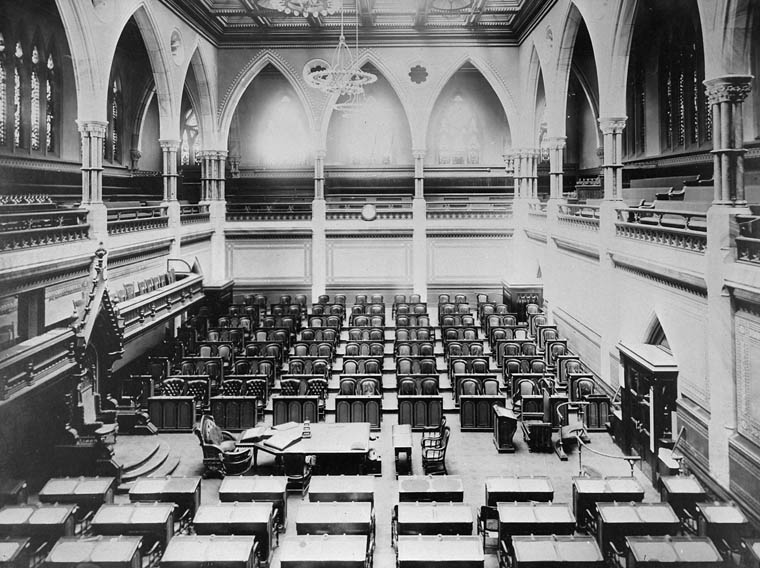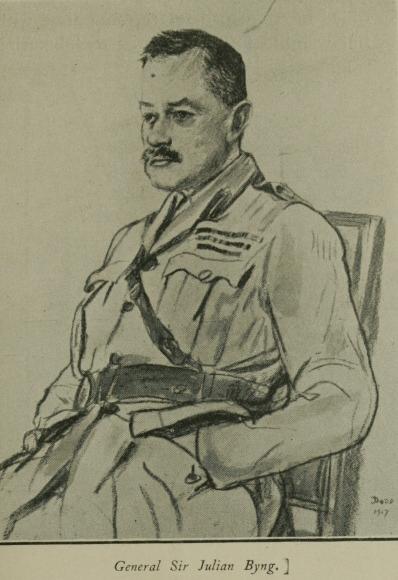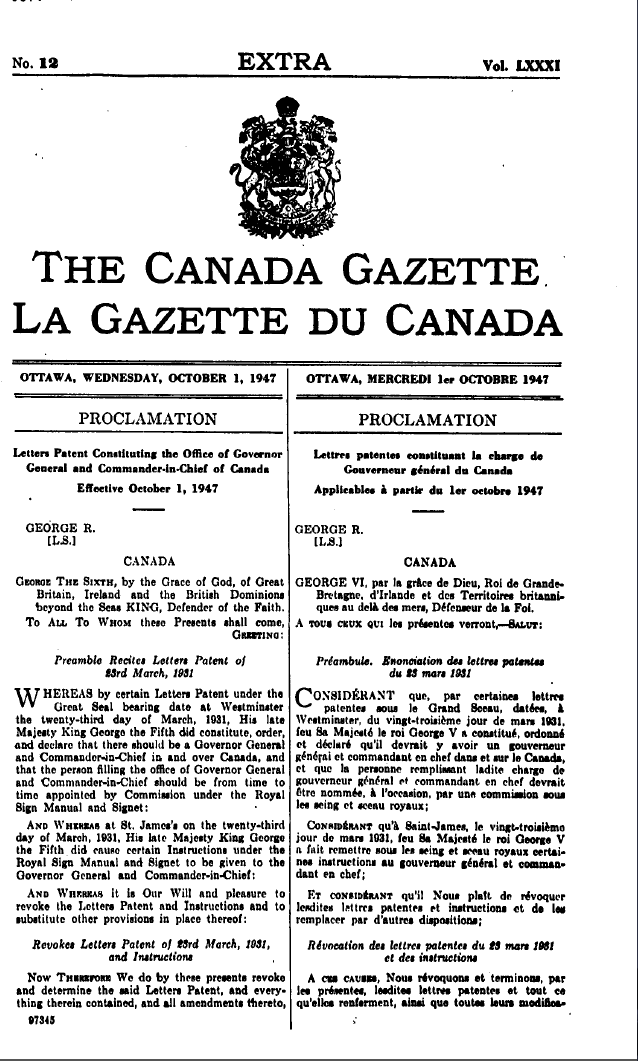|
1925 Canadian Federal Election
The 1925 Canadian federal election was held on October 29, 1925 to elect members of the House of Commons of Canada of the 15th Parliament of Canada. The Conservative party took the most seats in the House of Commons, although not a majority. Prime Minister William Lyon Mackenzie King's Liberal Party was invited to form a minority government. Unlike the Conservative party, King's Liberals had the conditional support of the many Farmer/Progressive MPs. The government fell the following year. Governor General Baron Byng of Vimy offered the Conservatives under Meighen a chance to form government. This too fell in short order. Byng's action precipitated the " King–Byng Affair", which became the main issue of the 1926 election. Background The previous federal election in 1921 had seen Mackenzie King's Liberals fall narrowly short of winning a parliamentary majority, with Arthur Meighen's Conservatives falling to being the third-largest party, and the new Progressive Party, w ... [...More Info...] [...Related Items...] OR: [Wikipedia] [Google] [Baidu] |
House Of Commons Of Canada
The House of Commons of Canada (french: Chambre des communes du Canada) is the lower house of the Parliament of Canada. Together with the Crown and the Senate of Canada, they comprise the bicameral legislature of Canada. The House of Commons is a democratically elected body whose members are known as members of Parliament (MPs). There have been 338 MPs since the most recent electoral district redistribution for the 2015 federal election, which saw the addition of 30 seats. Members are elected by simple plurality ("first-past-the-post" system) in each of the country's electoral districts, which are colloquially known as ''ridings''. MPs may hold office until Parliament is dissolved and serve for constitutionally limited terms of up to five years after an election. Historically, however, terms have ended before their expiry and the sitting government has typically dissolved parliament within four years of an election according to a long-standing convention. In any case, an ac ... [...More Info...] [...Related Items...] OR: [Wikipedia] [Google] [Baidu] |
Julian Byng, 1st Viscount Byng Of Vimy
Field Marshal Julian Hedworth George Byng, 1st Viscount Byng of Vimy, (11 September 1862 – 6 June 1935) was a British Army officer who served as Governor General of Canada, the 12th since the Canadian Confederation. Known to friends as "Bungo", Byng was born to a noble family at Wrotham Park in Hertfordshire, England and educated at Eton College, along with his brothers. Upon graduation, he received a commission as a militia officer and saw service in Egypt and Sudan before enrolling in the Staff College at Camberley. There, he befriended individuals who would be his contemporaries when he attained senior rank in France. Following distinguished service during the First World War—specifically, with the British Expeditionary Force in France, in the Battle of Gallipoli, as commander of the Canadian Corps at Vimy Ridge, and as commander of the British Third Army—Byng was elevated to the peerage in 1919. In 1921, King George V, on the recommendation of Prime Minister D ... [...More Info...] [...Related Items...] OR: [Wikipedia] [Google] [Baidu] |
Progressive-Conservative (candidate)
The label Progressive-Conservative was used by some candidates for the House of Commons of Canada in the 1925, 1926, 1930 and 1935 federal elections. The term probably indicates that these candidates were supporters of both the Progressive Party of Canada and the Conservative Party. In 1942, the Conservative Party renamed itself the Progressive Conservative Party of Canada when the former Progressive Premier of Manitoba, John Bracken, became the party leader. Most Progressives, however, had previously joined the Liberal Party of Canada. The only ''Progressive-Conservative'' candidate to be elected to the House of Commons was Errick Willis. Willis first sought election to the House of Commons of Canada in the 1926 federal election as a ''Progressive-Conservative'' candidate in the riding of Souris, Manitoba. He was defeated by Progressive candidate James Steedman, who won 6,105 votes to Willis’ 4,946 votes. In the 1930 federal election, Willis, again running as a "Progre ... [...More Info...] [...Related Items...] OR: [Wikipedia] [Google] [Baidu] |
Liberal-Progressive
Liberal-Progressive was a label used by a number of candidates in Canadian elections between 1925 and 1953. In federal and Ontario politics, there was no Liberal-Progressive party: it was an alliance between two parties. In Manitoba, a party existed with this name. Federal politics With the Progressive Party of Canada's 1921 electoral breakthrough, Canadian federal politics operated under a "three party system" for the first time. The Liberal Party of Canada under William Lyon Mackenzie King tried to deal with this situation by co-opting the Progressives, offering to form a coalition with them. The Progressive Party refused. But by 1926, the party had split and some Progressives decided to support the Liberals, running as liberal progressive or Liberal-Labour-Progressive candidates or similar variations. This phenomenon occurred particularly in the 1925 election and the 1926 election. A number of Liberal-Progressive Members of Parliament became full-fledged Liberals in the 193 ... [...More Info...] [...Related Items...] OR: [Wikipedia] [Google] [Baidu] |
Conservative Party Of Canada (1867-1942)
The Conservative Party of Canada (french: Parti conservateur du Canada), colloquially known as the Tories, is a federal political party in Canada. It was formed in 2003 by the merger of the two main right-leaning parties, the Progressive Conservative Party (PC Party) and the Canadian Alliance, the latter being the successor of the Western Canadian-based Reform Party. The party sits at the centre-right to the right of the Canadian political spectrum, with their federal rival, the Liberal Party of Canada, positioned to their left. The Conservatives are defined as a "big tent" party, practising "brokerage politics" and welcoming a broad variety of members, including " Red Tories" and " Blue Tories". From Canadian Confederation in 1867 until 1942, the original Conservative Party of Canada participated in numerous governments and had multiple names. However, by 1942, the main right-wing Canadian force became known as the Progressive Conservative Party. In the 1993 federal elec ... [...More Info...] [...Related Items...] OR: [Wikipedia] [Google] [Baidu] |
1921 Canadian Federal Election
The 1921 Canadian federal election was held on December 6, 1921, to elect members of the House of Commons of Canada of the 14th Parliament of Canada. The Union government that had governed Canada through the First World War was defeated, and replaced by a Liberal government under the young leader William Lyon Mackenzie King. A new third party, the Progressive Party, won the second most seats in the election. Since the 1911 election, the country had been governed by the Conservatives, first under the leadership of Prime Minister Robert Borden and then under Prime Minister Arthur Meighen. During the war, the Conservatives had united with the pro-conscription Liberal-Unionists and formed a Union government. A number of Members of Parliament (MPs), mostly Quebecers, stayed loyal to Sir Wilfrid Laurier, however, and they maintained their independence. When Laurier died, he was replaced as leader by the Ontarian Mackenzie King. After the 1919 federal budget, a number of west ... [...More Info...] [...Related Items...] OR: [Wikipedia] [Google] [Baidu] |
1925 Canadian Parliament English Version
Nineteen or 19 may refer to: * 19 (number), the natural number following 18 and preceding 20 * one of the years 19 BC, AD 19, 1919, 2019 Films * ''19'' (film), a 2001 Japanese film * ''Nineteen'' (film), a 1987 science fiction film Music * 19 (band), a Japanese pop music duo Albums * ''19'' (Adele album), 2008 * ''19'', a 2003 album by Alsou * ''19'', a 2006 album by Evan Yo * ''19'', a 2018 album by MHD * ''19'', one half of the double album '' 63/19'' by Kool A.D. * '' Number Nineteen'', a 1971 album by American jazz pianist Mal Waldron * ''XIX'' (EP), a 2019 EP by 1the9 Songs * "19" (song), a 1985 song by British musician Paul Hardcastle. * "Nineteen", a song by Bad4Good from the 1992 album ''Refugee'' * "Nineteen", a song by Karma to Burn from the 2001 album ''Almost Heathen''. * "Nineteen" (song), a 2007 song by American singer Billy Ray Cyrus. * "Nineteen", a song by Tegan and Sara from the 2007 album '' The Con''. * "XIX" (song), a 2014 song by Slipkn ... [...More Info...] [...Related Items...] OR: [Wikipedia] [Google] [Baidu] |
By-election
A by-election, also known as a special election in the United States and the Philippines, a bye-election in Ireland, a bypoll in India, or a Zimni election ( Urdu: ضمنی انتخاب, supplementary election) in Pakistan, is an election used to fill an office that has become vacant between general elections. A vacancy may arise as a result of an incumbent dying or resigning, or when the incumbent becomes ineligible to continue in office (because of a recall, election or appointment to a prohibited dual mandate, criminal conviction, or failure to maintain a minimum attendance), or when an election is invalidated by voting irregularities. In some cases a vacancy may be filled without a by-election or the office may be left vacant. Origins The procedure for filling a vacant seat in the House of Commons of England was developed during the Reformation Parliament of the 16th century by Thomas Cromwell; previously a seat had remained empty upon the death of a member. Crom ... [...More Info...] [...Related Items...] OR: [Wikipedia] [Google] [Baidu] |
Prince Albert, Saskatchewan
Prince Albert is the third-largest city in Saskatchewan, Canada, after Saskatoon and Regina. It is situated near the centre of the province on the banks of the North Saskatchewan River. The city is known as the "Gateway to the North" because it is the last major centre along the route to the resources of northern Saskatchewan. Prince Albert National Park is located north of the city and contains a wealth of lakes, forest, and wildlife. The city itself is located in a transition zone between the aspen parkland and boreal forest biomes. Prince Albert is surrounded by the Rural Municipality of Prince Albert No. 461, of which it is the seat, but is politically separate. History The area was named ''kistahpinanihk'' by the Cree, which translates to "sitting pretty place", "great meeting place" or "meeting place". The first trading post set up in the area was built in 1776 by Peter Pond. James Isbister, an Anglo-Métis employee of the Hudson's Bay Company, settled on the ... [...More Info...] [...Related Items...] OR: [Wikipedia] [Google] [Baidu] |
Governor General Of Canada
The governor general of Canada (french: gouverneure générale du Canada) is the federal viceregal representative of the . The is head of state of Canada and the 14 other Commonwealth realms, but resides in oldest and most populous realm, the United Kingdom. The , on the advice of Canadian prime minister, appoints a governor general to carry on the Government of Canada in the 's name, performing most of constitutional and ceremonial duties. The commission is for an indefinite period—known as serving '' at Majesty's pleasure''—though five years is the usual length of time. Since 1959, it has also been traditional to alternate between francophone and anglophone officeholders—although many recent governors general have been bilingual. The office began in the 17th century, when the French crown appointed governors of the colony of Canada. Following the British conquest of the colony, the British monarch appointed governors of the Province of Quebec (later the C ... [...More Info...] [...Related Items...] OR: [Wikipedia] [Google] [Baidu] |
William Stevens Fielding
William Stevens Fielding, (November 24, 1848 – June 23, 1929) was a Canadian Liberal politician, the seventh premier of Nova Scotia (1884–96), and the federal Minister of Finance from 1896 to 1911 and again from 1921 to 1925. Early life He was born in Halifax, Nova Scotia. Fielding became leader of the Anti-Confederation Party ( Nova Scotia Liberal Party). In 1884, he became Premier and won the 1886 election on a pledge to remove Nova Scotia from confederation. When he failed to do this, he turned to economic matters including developing the coal industry. The Liberal Party of Nova Scotia fared poorly in national elections during the 1880s and early 1890s. The national party advocated policies that would discontinue the national coal subsidy and, for all practical purposes, eliminate Catholic schools in Manitoba, policies disliked by provincial coal miners and Catholics respectively. Fielding forged a more moderate coal policy and defused the school issue, winning bac ... [...More Info...] [...Related Items...] OR: [Wikipedia] [Google] [Baidu] |



.jpg)


